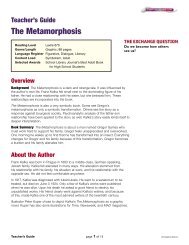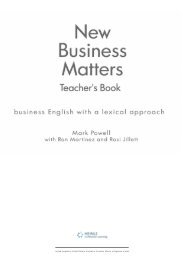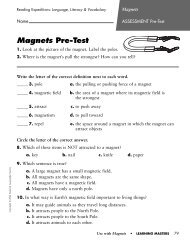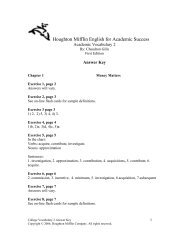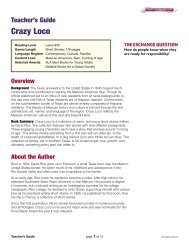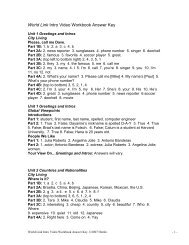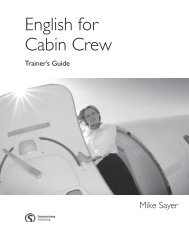Top 20, Great Grammar for Great Writing, First Edition Teaching Notes
Top 20, Great Grammar for Great Writing, First Edition Teaching Notes
Top 20, Great Grammar for Great Writing, First Edition Teaching Notes
You also want an ePaper? Increase the reach of your titles
YUMPU automatically turns print PDFs into web optimized ePapers that Google loves.
<strong>Top</strong> <strong>20</strong>, <strong>Great</strong> <strong>Grammar</strong> <strong>for</strong> <strong>Great</strong> <strong>Writing</strong>, <strong>First</strong> <strong>Edition</strong><strong>Teaching</strong> <strong>Notes</strong>http://esl.college.hmco.com/instructorsCopyright Houghton Mifflin CompanyChapter 19 – Confusing Pairs of Words: Verbs and NounsOverviewThis chapter focuses on pairs of words that students often confuse. The chapter isdivided into the following sections: verb and noun pairs, verb pairs, the verb get, verbsthat use the infinitive without to, and noun pairs.<strong>Teaching</strong> <strong>Notes</strong>Verbs and Nouns (19.1)Introduce the pairs of words by having students listen <strong>for</strong> any differences inpronunciation between the words. Point out the differences in pronunciation (whereapplicable) and meaning. Use the words in sentences and ask students to listen and thendetermine whether the correct word was used ( I need you to advice me vs. I need you toadvise me, <strong>for</strong> example). Follow with Exercise 1. To correct the exercise, ask students totake turns reading the passage aloud. When they come to an error in the passage, havethem read the word as it is written and then supply the correct word (pronunciation andspelling). Ask students to complete Exercise 2 and share their sentences first with apartner; the partner should check <strong>for</strong> errors. Finally, ask students to share their sentenceswith the group.Verb Pairs (19.2)Introduce the pairs of words in small groupings, perhaps three or four at a time. For eachgrouping, review the pairs and ask students to provide examples of their own. Whenstudents have covered three or four groupings, have them review the pairs.To review, write each word on an index card and its use on another (come; to movetowards something). Put students in groups of three and give them the stack of reviewcards. Put all cards face down on the table and tell students they have to match the verbcard with its use card. To begin, one student turns one card face up and then turnsanother face up. If they are a match, the student must use the verb in a sentence correctlyin order to keep the matched pair. If the cards are not a match, or if the student offers anincorrect sentence, the cards are placed face down and the next student receives a turn.After students have reviewed all the verb pairs and practiced, ask them to completeExercise 3. Correct the exercise as a group. Follow with Exercise 4, asking students toshare their sentences with their classmates.1



